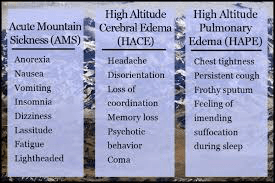
There are many things to look into when you’re going on your next expedition; airfare, places to stay and of course where you will be skiing. Something else you might want to consider is how the places you are visiting will affect you physically. There are the obvious altitude sicknesses but one that could be life-threatening if not realized soon enough is HAPE (High-altitude pulmonary edema). HAPE is when your lungs start to accumulate fluid when ascending too quickly.

Typically HAPE occurs in people that live in lower elevations who visit significantly higher elevations but there are also some cases of acclimated people visiting sea level, coming home and noticing the symptoms. Coughing, wheezing, weakness in breathing and reduced stamina are how HAPE starts but can suddenly change your skin a blueish tinge or tachycardia (rapid heart rate). So if you are in the market to fly from sea level especially I would suggest you start taking some trips to higher elevations before conquering the next big line or summiting a few peaks in a new place.

Although life-threatening, HAPE is preventable and treatment is available as well. Some guidelines to follow when ascending especially on longer expeditions are to only ascend for three to four days at a time and to keep your sleeping elevations within 1,600 ft every day. Even when these are not a part of the plan it is also a good idea to take a rest day after big gains in elevation and have nifedipine on hand. Nifedipine is a pulmonary vasodilator, which means it widens blood vessels by relaxing the smooth muscle cells within the vessels. Once diagnosed the first step is to start descending right away, with improvements seen almost right away. The next steps are to take the nifedipine and usually doctors will put patients on oxygen therapy after as well.
With correct prevention and care if diagnosed in time HAPE is containable. Ascending in the 14,800 ft range the percent of HAPE is about 0.2 – 6% and at 18,000 ft it is 2 – 15%. An example is that about 1 in 50 people get HAPE ascending Denali which is 20,310 ft above sea level!
https://en.wikipedia.org/wiki/High-altitude_pulmonary_edema
https://www.altitude.org/altitude-sickness